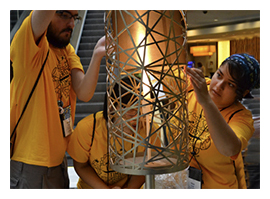

GRADES: 5-8, 9-12
SUBJECT: Science/Energy
A school building is an energy system made of many interrelated components. Some of the components are obvious — walls, roofs, lights, air vents, doors, and windows. The occupants — students, teachers, and other building users — are also an important part of the system. 
The energy use of the system affects everything from the school budget to the global environment. It is important to understand how all of the system components can work together to create an environment that is conducive to teaching and learning. The School Energy Survey will help guide junior high and high school students interested in energy-related careers.
LESSON SUMMARY: The School Energy Survey is designed to give students the necessary background and framework to conduct an energy survey of their school building. The step-by-step approach guides students through the process of analyzing energy consuming appliances and systems. After gathering data, students identify energy-related issues and brainstorm solutions. Students then rate the costs and benefits associated with their proposed solutions and put together an action plan. Finally, as an extension, students can monitor the impacts of their plan over time. At each step, graphic organizers and charts are provided to help students structure their plan.
The School Energy Survey also introduces students to careers available in the energy management industry. Energy analysts perform energy studies on commercial, residential, and industrial buildings to determine cost-effective ways to save energy. The activities in the School Energy Survey closely parallel the tasks performed by engineers and other technicians in this growing field.
CURRICULUM: Science, Visual Arts, Language Arts
PLAN TIME: Approximately seven 45-minute class periods, plus out-of-class research and monitoring
MATERIALS:
STANDARDS: Next Generation Science Standards, Common Core and Sate Standards are listed at the beginning of the curriculum guide.
LESSON PLANS/ACTIVITY:
School Energy Survey (9 Activities): Teacher Guide
School Energy Survey (9 Activities): Student Guide
OWNER: The NEED Project